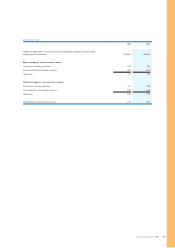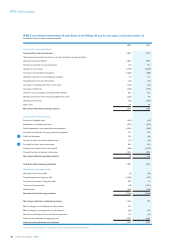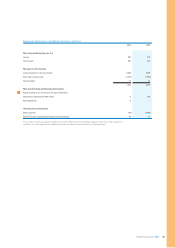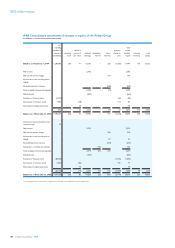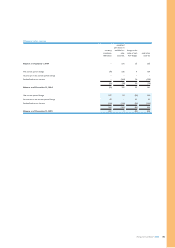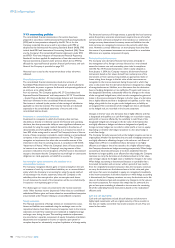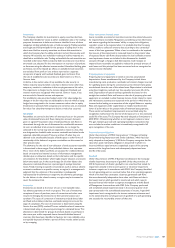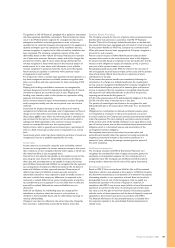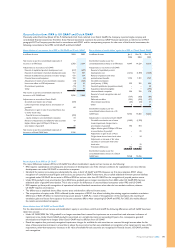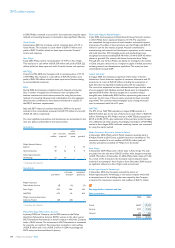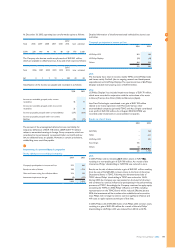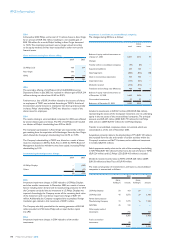Philips 2005 Annual Report Download - page 189
Download and view the complete annual report
Please find page 189 of the 2005 Philips annual report below. You can navigate through the pages in the report by either clicking on the pages listed below, or by using the keyword search tool below to find specific information within the annual report.
Philips Annual Report 2005 189
The guidance in IAS 18 “Revenue”, paragraph 13, is applied to transactions
thathaveseparatelyidentiablecomponents.Thesetransactionsmainly
occur in the Medical Systems segment for arrangements that require
subsequent installation and training activities in order to become
operable for the customer. However, since payment for the equipment is
typically contingent upon the completion of the installation process,
revenue recognition is required to be deferred until the installation has
been completed. The Company recognizes revenues of the other
deliverables based on their relative fair values. Revenues are recorded
net of sales taxes, customer discounts, rebates and similar charges. For
productsforwhicharightofreturnexistsduringadenedperiod,
revenue recognition is determined based on the historical pattern of
actual returns, or in cases where such information is not available,
revenue recognition is postponed until the return period has lapsed.
Return policies are typically in conformity with customary return
arrangements in local markets.
For products for which a residual value guarantee has been granted or a
buy-back arrangement has been concluded, revenue recognition takes
place in accordance with the requirements for lease accounting of IAS
17 ‘Leases’.
Shipping and handling costs billed to customers are recognized as
revenues. Expenses incurred for shipping and handling costs of internal
movements of goods are recorded as cost of sales. Shipping and
handling costs related to sales to third parties are reported as selling
expenses and disclosed separately.
Service revenue related to repair and maintenance activities for goods
sold is recognized ratably over the service period or as services are
rendered.
A provision for product warranty is made at the time of revenue
recognitionandreectstheestimatedcostsofreplacementandfree-of
charge services that will be incurred by the Company with respect to
the products sold. In cases where the warranty period is extended andsold
the customer has the option to purchase such an extension, which is
subsequently billed separately to the customer, revenue recognition
occurs on a straight-line basis over the contract period.
Royalty income, which is generally earned based upon a percentage of
salesoraxedamountperproductsold,isrecognizedonanaccrual
basis.
Government grants, other than those relating to purchases of assets, are
recognizedasincomeasqualiedexpendituresaremade.
Income taxes
Income taxes are accounted for using the asset and liability method.
Income tax is recognized in the income statement except to the extent
that it relates to an item recognized directly within equity, in which case
the related tax effect is also recognized there.
Current tax is the expected tax payable on the taxable income for the
year, using tax rates enacted or substantially enacted at the balance
sheet date, and any adjustment to tax payable in respect of previous
years. Deferred tax assets and liabilities are recognized for the expected
tax consequences of temporary differences between the tax bases of
assets and liabilities and their reported amounts. Measurement of
deferred tax assets and liabilities is based upon the enacted or
substantially enacted tax rates expected to apply to taxable income in
the years in which those temporary differences are expected to be
recovered or settled. Deferred tax assets, including assets arising from
loss carryforwards, are recognized if it is more likely than not that the
asset will be realized. Deferred tax assets and liabilities are not
discounted.
Deferred tax liabilities for withholding taxes are recognized for
subsidiaries in situations where the income is to be paid out as
dividends in the foreseeable future, and for undistributed earnings of
minority shareholdings.
Changesintaxratesarereectedintheperiodwhenthechangehas
been enacted or substantively enacted by the balance sheet date.
EmployeeBenetAccounting
The Company accounts for the cost of pension plans and postretirement
benetsotherthanpensionsinaccordancewithIAS19‘Employee
Benets’.MostoftheCompany’sdened-benetplansarefundedwith
plan assets that have been segregated and restricted in a trust to provide
forthepensionbenetstowhichtheCompanyhascommitteditself.
When plan assets have not been segregated the Company recognizes a
provision for such amounts.
Pensioncostsinrespectofdened-benetpensionplansprimarily
represent the increase in the actuarial present value of the obligation
forpensionbenetsbasedonemployeeserviceduringtheyearandthe
interest on this obligation in respect of employee service in previous
years, net of the expected return on plan assets.
Recognized prepaid assets under IFRS are limited to the net total of
any unrecognized actuarial losses and past service costs and the present
value of any future refunds from the plan or reductions in future
contributions to the plan.
Totheextentthatpensionbenetsvestimmediatelyfollowingthe
introductionofachangetoadened-benetplan,theresultingpast
service costs are recognized immediately. The Company recognizes for
eachdened-benetplanaportionofitsactuarialgainsandlossesas
income or expense if the net cumulative unrecognized actuarial gains
andlossesforeachdened-benetplanattheendoftheprevious
reporting period exceeded the greater of:
1)10%ofthepresentvalueofthedened-benetobligationatthatdate;
2) 10% of the fair value of any plan asset at that date.
The portion of actuarial gains and losses to be recognized for each
dened-benetplanistheexcessabove10%under1)or2)dividedby
5 years.
Obligationsforcontributionstodened-contributionpensionplans
are recognized as an expense in the income statement as incurred.
Incertaincountries,theCompanyalsoprovidespostretirementbenets
other than pensions. The cost relating to such plans consists primarily
ofthepresentvalueofthebenetsattributedonanequalbasistoeach
yearofservice,interestcostontheaccumulatedpostretirementbenet
obligation, which is a discounted amount, and amortization of the
unrecognized transition obligation.
Unrecognized prior-service costs related to pension plans and
postretirementbenetsotherthanpensionsarebeingamortizedby
assigning a proportional amount to the income statements of a
numberofyears,reectingtheaverageremainingserviceperiodof
the active employees.
Stock-based compensation
The Company complies with IFRS 2 ‘Share-based Payments’ and
recognizes the estimated fair value of equity instruments granted to
employees as compensation expense over the vesting period on a
straight-line basis. The Company uses the Black and Scholes option-
pricing model to determine the fair value of the equity instruments.
Discontinued operations
Based on IFRS 5 ‘Non-current Assets Held for Sale and Discontinued
Operations’, which is early adopted as from January 1, 2004 the Company
has determined its businesses as components of an entity for the purpose
ofassessingwhetherornotoperationsandcashowscanbeclearly
distinguished from the rest of the Company, in order to qualify as a
discontinued operation in the event of disposal of a business. In
compliance with IFRS 5, non-current assets held for sale and discontinued
operations are carried at the lower of carrying amount and fair value
less costs to sell. Any gain or loss from disposal of a business, together
with the results of these operations until the date of disposal, is reported
separately as discontinued operations in accordance with IFRS 5.
Thenancialinformationofadiscontinuedbusinessisexcludedfrom
therespectivecaptionsintheconsolidatednancialstatementsand
related notes.


